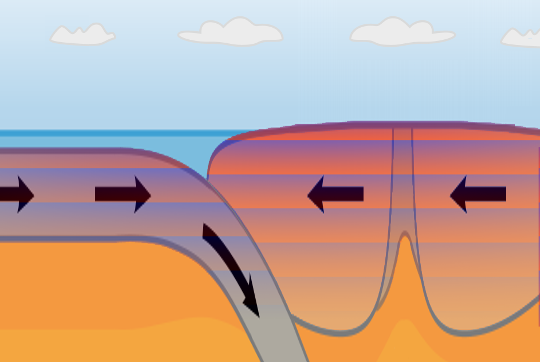After the boxing day & Japanese earthquake and Tsunamis are geologists ignoring a vital tool that could be used to help predict earthquakes?
In the last article I provided a quick summary of the Caterpillar theory of plate tectonic movement. Put very simply, this is that warming & cooling over 1000s of years causes the crust to expand and contract. Expansion pushes the crust down at subduction Zones and contraction cause it to shrink causing fissures to form in the mid oceans which are then filled with magma which solidifies.
The result is that when the earth is subject to regular cooling and warming as we have over the 100,000 ice age cycle, this will cause the earth’s crust to move rather in the form of some caterpillars.
However, so far I have just treated the crust as a single entity. In reality, the above “arching” of the back of the caterpillar is very realistic. Because far from the entire crust expanding and contracting, the reality is that the expansion and contraction is greatest near the surface.

Change in crust temperature. Note, this is the change in temperature on top of the ADDITIONAL temperature gradient as we get deeper into the crust.
But there is another curiosity. For simplicity, I’m going to refer here only to the change in temperature due to thermal change at the surface without the general increase we get with depth. So, when I say “cooler”, that is cooler with respect to a nominal very long-term temperature we expect at that depth.
Notice for example, if we pick the yellow line starting at +2C. Here the surface shows less warming due to this cycle than a few hundred meters down. So whereas the surface is beginning to cool, down at 1000m, the crust is still expanding. If we then look at the next green curve. We see that crustal cooling has reached down to around 1.2km. So above 1.2km, the crust is now cooling, but below 1.2km the drop in temperature that occurred has still not penetrated to that depth and it is still responding to the previous cooling of the globe from almost 100,000 years before.
However, if we go even further down into the rock, whilst the amplitude diminishes, we find that whilst the surface is cooling, then lower the rock is warming, if we go further down we find that again the rock is cooling and below that it is warming. So, in effect the temperature of the surface is going down through the crust in waves.
The Caterpillar Theory and Earthquakes
Therefore, one prediction of the caterpillar theory of plate movement is that earthquake zones should be depth related and that the depth of earthquakes should gradually move down into the crust over thousands of years.
Differential thermal expansion
Below is the graphic showing how expansion of the crust leads to earthquakes. What it does not show, is that almost invariably, the rock on either side of the subduction zone will be of different types and therefore expand at different rates.
 Nor does it show how the waves of expansion and cooling will move down into the crust. So, in a real situation with different rock on either side, the situation swill be more like the following:
Nor does it show how the waves of expansion and cooling will move down into the crust. So, in a real situation with different rock on either side, the situation swill be more like the following:

Subduction zone (extended vertical scale) showing waves of ice-age cycles going down into the ground with rocks with different thermal conductivity on each side. (Note in reality the isotherms will be curved near the fault line, but for simplicity this has not been shown).
Now, instead of the rock expanding or contracting uniformly across the fault line with a gradual change with depth. Now, there are a series of pulses of hot and cold going into the ground and along the fault line one side may be cooling whilst the other is warming. Now these zones of stress will move slowly into the ground making it very likely that they will at some point trigger an earthquake.


Pingback: Could global warming be delaying the “Big one” earthquake (re WUWT) | Scottish Sceptic
You left out the terrestial thermocline?
The orbital surface temperature forcing occurs at rates on the order of microkelvins/day . Given the thermal diffusivity of crustal rocks, , the upwelling geothermal flux remains dominant.